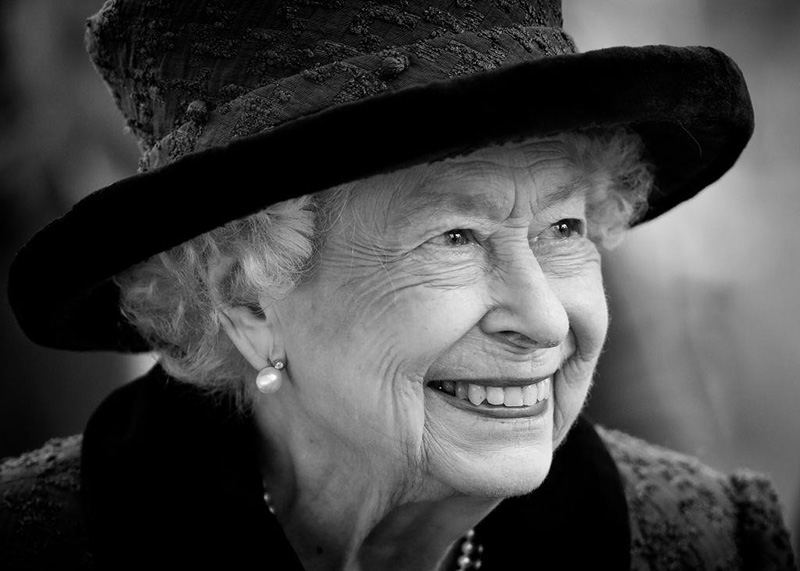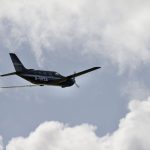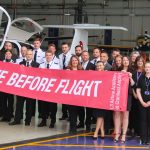Cranfield Airport selected for trial area to
advance UAS integration

17 October 2023
Cranfield Airport has been selected by the Civil Aviation Authority to participate in a Temporary Reserved Area (TRA) Regulatory Sandbox accommodating the operation of unmanned and manned aircraft in unsegregated airspace.
The TRA designation will enable Cranfield Airport to host projects and trials that will help to integrate unmanned aircraft such as drones into shared airspace. With estimates that the increased use of drones could contribute £45 billion to the UK economy by 2030, their use is expected to expand rapidly in the coming years. Developing the technical capacity and expertise to operate them safely alongside other aircraft is key.
The TRA Sandbox forms part of the Airspace Modernisation Strategy which outlines a roadmap for the development and modernisation of UK airspace. The Cranfield Airport TRA is agnostic to technology, agnostic to market definitions and will facilitate an open access trials environment managed by Cranfield’s Air Traffic Control as the Air Navigation Service Provider.
Sandbox vital to unlock potential of drones
The new TRA will allow the airport to host projects that demonstrate and validate technologies, airspace management procedures and flight operation procedures that support the safe, efficient and managed integration of drone operations and crewed aircraft. Live testing of operations and technologies will provide safety mitigation evidence and help to establish standards, enabling the CAA to develop regulatory guidance in this crucial area.
Cranfield Airport has experience and expertise within its Air Traffic Control of enabling UAS activity with navigation and other projects.
Airport Operations Director Rob Abbott said: “The airspace of the future will be increasingly complex. The TRA Sandbox is a clear indication of the CAA’s support for innovation and seeks to address the need to progress adoption of manned and unmanned aircraft in UK Airspace. I’m pleased that Cranfield Airport with this TRA Sandbox will host more groundbreaking projects and trials to improve industry knowledge, processes and systems. This is vital to unlocking the potential of commercial drone use, and safely bringing UAS aircraft into shared airspace.”
Industry partners will use TRA to develop commercial drone use
Working with advice and guidance from the CAA, Cranfield Airport already expects several consortiums and industry partners to use the TRA including Project Blueprint, Thales, Saab and HeroTech8.
Rob Abbott continued, “The approach we are taking to integrate, based on established ATS services, builds on years of experience at Cranfield. Cranfield’s Global Research Airport, operated by one of the world’s leading universities in aviation, is uniquely able to bring together the airport, air traffic control and operations for truly collaborative research and development.”
Neil Watson, Business Development Manager Airspace Mobility Solutions at Thales, said: “Thales is delighted to continue its long-standing relationship with Cranfield as an integral part of the UAS Temporary Reserved Airspace (TRA) Sandbox activities. We recognise the importance of the TRA as an important part of the roadmap to accommodate safe UAS BVLOS operations in a step-wise manner as set out in the UK Airspace Modernisation Strategy (AMS). The ability to operate drones and manage operationally representative airspace will enable technological, regulatory, societal and economic aspects of commercial drone operations to be better understood within the context of user driven use cases “
Per Ahl, Vice President and Head of Marketing & Sales at Saab’s business area Surveillance, said: “Saab is excited by this news of the TRA, given our existing digital tower system at Cranfield as well as our installed research tower system, to further advance UAS integration.
“This is an important first step towards validating an integrated concept of combined drone- and aircraft operations at or around an airport. Combining these new technologies with operational procedures will give valuable insights which will support the adaptation and development of new functionality for drone operations, as well as traditional airspace services for our digital tower solution.”
Project Blueprint aims to create a ‘blueprint’ for the UK-wide rollout of drone operations which can be commercialised at scale. It will be using the TRA Sandbox to create a beyond visual line of sight test environment, with a low-cost ground-based test and avoid network.
Professor Sir Iain Gray, Cranfield University’s Director of Aerospace, is Chair of the Drone Industry Action Group and says “The UK can be a global player in drone services and solutions and help to set the global standards and frameworks for us to reap longer term mobility and commercial benefits. To achieve this potential its essential we have these test environments to help industry and regulators to learn and collaborate.”
 A tribute to Her Majesty The Queen
A tribute to Her Majesty The Queen
09 September 2022
Cranfield University is deeply saddened to learn of the death of Her Majesty The Queen.
The University has long-standing ties to The Royal Family, with His Royal Highness The Duke of Edinburgh taking the Royal Visitor role for many years and becoming an active honorary graduate of the institution.
Chief Executive and Vice-Chancellor of Cranfield University, Professor Karen Holford CBE FREng, said: “We join the nation and indeed the world in mourning the passing of Her Majesty The Queen. She was much loved and widely respected around the globe, with an unparalleled dedication to public service throughout her 70-year reign.
“The Queen had a keen interest in higher education and how it shaped and developed lives across the world. Her loss will be deeply felt and our thoughts and prayers are with the whole Royal Family at this time.”
First ever cross-Channel hybrid electric flight lands at Cranfield
24 September 2021
The first flight by a hybrid electric aircraft across the English Channel has landed at Cranfield Airport in Bedfordshire.
VoltAero’s Cassio 1 demonstrator aircraft flew from Calais in northern France to the airport owned by Cranfield University and used electric propulsion for its take-off and landing.
During its stopover at Cranfield, on the way to the ACE21 Air Charter Expo, Cassio 1 was also presented to University faculty and students.
Professor Iain Gray, Director of Aerospace at Cranfield University, said: “It’s an honour to have this first cross-Channel flight by a hybrid electric aircraft land at Cranfield, and congratulations to the VoltAero team on this milestone achievement. It has also been a fantastic opportunity for our staff and students to see hybrid technology working in practice, which offers another step towards greener aviation.
”Rob Abbott, Director of Aviation Operations, Cranfield Airport, said: “We’re very proud to welcome VoltAero’s Cassio aircraft to the airport. As a fully-functional research airport, we are excited to engage with all types of manned and unmanned aircraft as we look to play our part in developing the aircraft, airport and airspace management systems of the future.”
VoltAero CEO and Chief Technology Officer Jean Botti added: “The stopover at Cranfield University introduced Cassio to the next generation of engineers, programme managers and decision-makers who are to lead the future of electric aviation. This Channel crossing clearly shows how VoltAero’s team has progressed in advancing the Cassio program through its development phase for a planned certification in 2023.”
The Cassio 1 demonstrator aircraft has flown more than 4,900 kilometres while validating VoltAero’s electric-hybrid power module, which combines electric motors with an internal combustion engine.
The module’s electric motors enable Cassio to perform nearly-silent take-offs and landings, while the internal combustion engine serves as a range extender by recharging batteries once Cassio is airborne, as well as providing a secondary source of propulsion and for backup.
Also in attendance for the landing was the team from KinectAir, a software aviation company focused on regional air mobility who work in partnership with VoltAero.
KinectAir is building a smartphone app that will enable people to order a direct flight from the nearest airfield to take them wherever they wish to go. Artificial intelligence software will continuously optimise the air transportation supply and passenger demand across KinectAir’s operated network of aircraft.
Nick Rogers, Chief Commercial Officer, KinectAir, said: “VoltAero is at the forefront of hybrid electric propulsion in conventional take-off and landing aircraft, which is the emerging leader for making regional air travel greener. We place these aircraft on a network and put the power to summon them in the hands of ordinary passengers. It will open up access to more sustainable air travel and is an exciting partnership for the future of transport connectivity.”
Cranfield and Marshall of Cambridge sign option agreement for Air Park development site
06 October 2020
Cranfield University and Marshall of Cambridge have today announced that they have signed an option agreement for the potential relocation of Marshall Aerospace and Defence Group (MADG) to Cranfield Airport.
The agreement follows extensive talks between both organisations, following the announcement in May 2019 of Cranfield as one of the preferred sites for the relocation of MADG from its current site at Cambridge Airport.
The agreement, which would enable MADG to complete its proposed move by 2030 as planned, provides the company with the right to take a 150-year lease on the University’s proposed Air Park development, which was granted outline planning permission by Central Bedfordshire Council in April 2018.
In December 2018, Cranfield Airport became the first airport in the UK to operate a digital air traffic control centre. The airport was also recently the location for the world’s first hydrogen-powered, commercial-scale aircraft.
Professor Sir Peter Gregson, Vice-Chancellor and Chief Executive of Cranfield University, said: “We are delighted to be progressing our talks with Marshall through the signing of this option agreement.
“Located at the heart of the Oxford-Cambridge Arc, Cranfield with its global research airport and MADG would provide a vibrant ecosystem of research, technology demonstration and innovation in aerospace that is unrivalled in the UK.
“We believe the relocation of MADG to Cranfield would further strengthen the partnership between one of the UK’s leading privately-owned aerospace and defence companies and one of the UK’s leading aerospace and defence universities.”
“Together with our partners in local government and in industry, Cranfield will be progressing our plans with MADG to realise this vision.”
Marshall Aerospace and Defence Chief Executive, Gary Moynehan, explains: “While it is important to note that the signing of the agreement does not represent a final decision to relocate Marshall Aerospace and Defence to Cranfield, we are pleased to have been able to secure such a credible relocation option.
“We are particularly excited by Cranfield’s global research airport and are already collaborating closely with them on a number of R&D projects. As such, the signing of this option agreement represents a further strengthening of a valuable relationship that I am sure will deliver significant benefits to all parties over the years ahead.”

Cranfield supports ZeroAvia’s world first hydrogen-electric passenger aircraft flight
25 September 2020
Cranfield University supported ZeroAvia in achieving the world’s first hydrogen fuel cell powered flight of a commercial-grade aircraft. The flight took place yesterday at the company’s R&D facility at the University-owned Cranfield Airport.
The Piper M-class six-seat plane completed taxi, takeoff, a full pattern circuit, before landing back at the airport. The flight was watched by the Aviation Minister, Robert Courts.
ZeroAvia were assisted by Cranfield Aerospace Solutions in achieving certification from the Civil Aviation Authority for the aircraft.
Commenting on the achievement by ZeroAvia, Professor Iain Gray, Director of Aerospace at Cranfield University, said: “This is a momentous day for the aerospace and the aviation industry. Arguably, this is as a big a moment in aerospace as any in the last 75 years, comparable with the first flight of the jet engine.
“Thanks to ZeroAvia, it is fantastic to see the UK leading the world in moves to zero-emission aviation and this could be the start of the UK leading the world in a new generation of hydrogen aircraft. We are tremendously proud that ZeroAvia hasve chosen to develop their technology at our global research airport and we look forward to continuing to support their efforts.”
Rob Abbott, Director of Aviation Operations at Cranfield University, said: “All of us at Cranfield Airport are proud to have supported the world’s first hydrogen- powered, commercial-grade aircraft’s flight by ZeroAvia. This marks another momentous occasion for the aAirport and demonstrates further our commitment to innovation.”
Paul Hutton, Chief Executive of Cranfield Aerospace Solutions, said: “We are thrilled to have played our part in assisting ZeroAvia with the necessary certifications from the Civil Aviation Authority. This is a historic achievement and one in which we are proud at Cranfield Aerospace Solutions to have played our part in.”
Drones used to conduct automated inspections at Cranfield Airport
06 August 2020
Unmanned aerial vehicles (UAVs) have been used to inspect the runway at Cranfield Airport remotely for the first time.
The flights make use of ‘drone-in-a-box’ technology with the aim of enabling routine inspections to take place with UAVs that can be automatically deployed, recovered and recharged without the need for an on-site pilot.
In the future, drones could be used to inspect other areas such as perimeter fences and take place regularly – for example, in the morning before the Airport opens, and in the evening after closing – to detect damage or the presence of foreign objects which can be dangerous for aircraft.
Rob Abbott, Director of Aviation Operations at Cranfield Airport, said: “As a fully-functional research airport located on a university campus, this kind of technology demonstration and development exercise is very much in our DNA. Using UAVs to conduct inspections could reduce operational costs and is another example of the work we are doing to explore and harness the potential of unmanned aircraft.”
Edward Anastassacos, Managing Director of HEROTECH8, the company providing the ‘drone-in-a-box’ system, said: “We are very excited to be working on this with Cranfield Airport. We see enormous benefits to using drone-in-a-box technology for industrial inspection and monitoring applications. With Cranfield, we hope to demonstrate a continuous runway monitoring capability. These flights are a step towards fully automated, industrial drone operations at scale.”
Due to current visual line of sight (VLOS) restrictions, initial flights are inspecting half of the runway and take around 30 minutes, with the drones flying at 100 feet from the ground.
Flight requests to air traffic control are made prior to each flight and then images or videos taken are combined and uploaded to cloud storage for visual review.
Work is ongoing to automate the evaluation process with the use of more advanced sensors or thermal imaging cameras to detect and highlight hazards.
Regulations currently require UAVs to be operated within VLOS of the remote pilot at all times.
Cranfield Airport and Anthony Kinns Aviation Services agree extension of their longstanding refuelling partnership
23 July 2020
Cranfield Airport and Anthony Kinns Aviation Services (AKA) have announced an extension of their longstanding refuelling partnership.
AKA has supplied fuel and refuelling services to Cranfield Airport for 30 years and this new deal sees an extension of the partnership until 2025.
Under the new agreement, Cranfield Airport will become responsible for the in-house operational side of refuelling with AKA having responsibility for supplying the airport with fuel and hardware
Rob Abbott, Director of Aviation Operations at Cranfield University, said: “We are delighted to be renewing our partnership with AKA. This new arrangement will give Cranfield Airport enhanced operational control over refuelling while continuing to work with a fantastic local business in AKA.”
Anthony Kinns. Managing Director. Anthony Kinns Aviation (Services) Ltd, said: “Given the significant changes in the aviation environment, we have agreed with Cranfield Airport that each party should operate to its strengths in a collective way to provide the best possible service to the current and future customer base at Cranfield Airport. We are delighted to be continuing the long-standing partnership for a further 5 years.”
 Drone training for Cranfield Airport staff in anticipation of future integrated airspace
Drone training for Cranfield Airport staff in anticipation of future integrated airspace
19 February 2020
Staff and students at Cranfield University and its Airport have completed a remote pilot course for flying unmanned aerial vehicles (UAVs) as part of long-term planning for integrated airspace use by manned and unmanned aircraft.
The commercial UAV remote pilot course incorporated a ground school element for flight planning – covering principles of flight, rules and regulations of the air, using aviation charts, risk assessment and meteorology – and a flight assessment to check demonstration of basic pilot competence, including how to respond in an emergency and being able to operate safety features.
Rob Abbot, Director of Aviation Operations at Cranfield Airport, who completed the training with some of his team, said: “Integrating UAV operations with airport activities and manned aircraft operations is going to be key in the future as we look to unleash the potential of a modernised UK airspace. This training has given myself and my team a solid understanding of UAV operations and the issues around using unmanned aircraft.
“UAVs could potentially benefit manned aircraft operations in a number of ways, ranging from monitoring, maintenance and repair tasks to de-icing the wings of aircraft in cold weather conditions. At Cranfield, we are already looking at how we may be able to use them for runway and airfield perimeter inspections.”
The course was provided by Consortiq, who have permission from the Civil Aviation Authority (CAA) to provide approved UAV training, and was scheduled to help prepare students for the BAE UAV Swarm Challenge running again at Cranfield in March this year.
Students who complete the course will receive CAA-approved certificates for the ground school and flight assessment elements.
Alex Williamson, Experimental Research Fellow in UAV Operations in the Centre for Autonomous and Cyber-Physical Systems, Cranfield University, said: “Providing this kind of hands-on training is invaluable in giving staff and students an insight into the operational considerations of flying unmanned aircraft, together with a working appreciation of regulations affecting their use. This experience has further grown Cranfield’s competency in this area. It also ensures staff and students can maximise their research potential with respect to UAVs.”
Around 40 students from the Autonomous Vehicle Dynamics and Control MSc and Applied Artificial Intelligence MSc courses took the training along with Airport and academic staff.
Regulations currently require UAVs to be operated within visual line of sight of the remote pilot at all times. Through the ongoing creation of the National Beyond visual line of sight Experimentation Corridor (NBEC), Cranfield University is also working with partners Blue Bear Systems Research, Thales and Vodafone to provide a safe, managed environment for UAV experimentation, ultimately working towards their unsegregated operation with manned aircraft in both controlled and uncontrolled airspace.
L3’s new Airline Academy
site at Cranfield Airport
27 June 2019
L3 staff and cadets joined Cranfield staff this week to mark the opening of L3’s new Airline Academy site at Cranfield Airport. Training at the facility will begin on July 1 and by the end of 2019 the site will provide capacity for over 50 cadets on L3’s European training courses.
Cranfield at the
Paris International Air Show
17 June 2019
This week a team of academics from across Cranfield University will be exhibiting at the Paris International Air Show.
This year the theme of Cranfield’s exhibition is ‘Aviation and the Environment’ which will showcase the work emerging from both Cranfield’s global research airport and its urban observatory.
If you are attending the show please come and meet representatives from our Aerospace, Transport Systems and Environment and Agrifood themes who will be happy to talk about their work in areas such as aircraft electrification, digital aviation and environmental monitoring and mitigation.
Cranfield’s exhibition stand is located in Hall 2b at stand FG173.
At the air show, Cranfield will also be announcing plans for a major conference ‘Aviation and the Environment’ to be held at the University on 28-29 November 2019.
 Cranfield announced as one of three preferred locations for relocation of Marshall Aerospace and Defence Group
Cranfield announced as one of three preferred locations for relocation of Marshall Aerospace and Defence Group
13 May 2019
Marshall of Cambridge has announced today that it intends to relocate Marshall Aerospace and Defence Group (MADG) and that it has identified Cranfield as one of its three preferred locations.
Professor Sir Peter Gregson, Vice-Chancellor and Chief Executive of Cranfield University, said: “These are early-stage discussions but we are excited about this potential development on the Cranfield Air Park and look forward to having future productive discussions with Marshall.
“Located at the heart of the Oxford-Cambridge Arc, Cranfield has ambitious plans for our global research airport. These discussions with Marshalls are aligned with our approved Air Park and Masterplan planning applications.“This is an exciting time for Cranfield. Last year we were the first airport in the UK to install a digital air traffic control centre. We are currently developing the £67million Digital Aviation Research Technology Centre (DARTeC) which will help the UK unlock the potential of digital aviation.”
In its statement today, Marshall said:
“We will be progressing discussions with stakeholders for all three sites over the coming months and expect to be in a position to make an announcement sometime next year. This is a huge undertaking which will require careful planning and we anticipate that we will complete a move by 2030.”
 L3 expands its UK flight training with a new site at Cranfield Airport
L3 expands its UK flight training with a new site at Cranfield Airport
13 May 2019
New location to boost flight training capacity and support demand for L3’s Airline Academy cadet pilot programmes
L3 Commercial Aviation is expanding its UK Airline Academy operations with a new site at Cranfield Airport set to open in July 2019. The location will help to increase L3’s flight training capacity for cadets across its European training programmes.
“This investment will help to improve both the quality and capacity of our world-leading pilot training,” said Geoff van Klaveren, Vice President of L3 Airline Academy. “With its existing infrastructure, heritage in aviation and strong network with the industry, we believe that Cranfield represents an attractive location to expand our U.K. training capacity.”
“We welcome L3 to Cranfield University’s global research airport,” said Rob Abbott, Cranfield Airport’s Director of Aviation Operations. “We have an established track record of working with international companies to bring investment and employment to the region through world-class education and research. In L3, Cranfield Airport has a partner engaged not just in the basic principles of academy training, but with a clear strategy for pilots of the future.”By the end of 2019, L3 will operate more than 12 aircraft at Cranfield Airport, providing training capacity for more than 50 cadets. This represents another significant investment from L3 in the UK. By the end of the year, the site will have created over 27 dedicated permanent jobs within the local economy.
Cranfield University is the only university in Europe with its own airport and runway. Its students and researchers work with some of the world’s top aerospace companies on advanced technologies and innovations. L3’s presence on the site will provide opportunities for future collaborations with the university on next-generation products and technologies.

